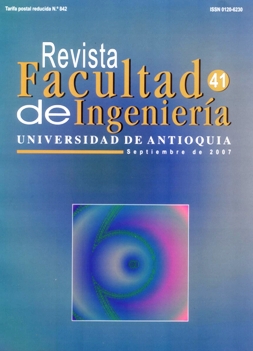Pinturas pigmentadas con magnetita dopada: evaluación preliminar de propiedades anticorrosivas
DOI:
https://doi.org/10.17533/udea.redin.19013Keywords:
Coatings, paints, impedance, magnetite, copper, chromium, corrosionAbstract
Pure magnetite and magnetite doped with three different concentrations of chromium and copper was lab synthesized. The relative performance of these products as anticorrosive pigments is compared with commercially available hematite (red iron oxide). Special mixtures of the pigments with a solventless epoxy binder were prepared maintaining the pigment volume contents near the practical critical value. The purpose was to distinguish the inhibitive action of pigments with the least possible influence from the barrier properties of the epoxy resin. The performance of mixtures applied on mild steel is characterized in accelerated outdoor exposure, in alternated immersion tests and in total immersion conditions. The latter test was monitored with open circuit potential and impedance measurements. Complementary tests with freestanding films were also performed. The results show that magnetite is not an inert pigment. Therefore presence of doping elements can improve the performance of anticorrosive magnetite paints. Based on this result, a complete formulation with pigment, solvent and additives is suggested and preliminarily tested in the lab aiming at producing an anticorrosive primer.
Downloads
References
B. R. Chakraborty, K. Verma. “Studies of a new inhibitive pigment for the corrosion control of mild steel in fertilizer plants”. Corrosion Prevention & Control. Vol. 34. 1987. pp. 127-132.
J-M. Hu, J.T. Zhang, J-Q. Zhang, C.N.Cao. “Corrosion electrochemical characteristics of red iron oxide pigmented epoxy coatings on aluminum alloys”. Corrosion Science. Vol. 47. 2005. pp. 2607–2618. DOI: https://doi.org/10.1016/j.corsci.2004.11.009
L.R. Miranda, L. Sathler, R. Nogueira, S.L.D.C. Brasil. “Atmospheric corrosion tests in Brazilian Legal Amazon - field and laboratory tests”. Materials and Corrosion. Vol. 51. 2000. pp.182-185. DOI: https://doi.org/10.1002/(SICI)1521-4176(200003)51:3<182::AID-MACO182>3.0.CO;2-3
M. M. Thackeray, W. I. David, J. B. Goodenough. “Structural characterization of the lithiated iron oxides LixFe3O4 and LixFe2O3 (0 DOI: https://doi.org/10.1016/0025-5408(82)90029-0
B. García, A. Lamzoudi, F. Pillier, H. Nguyen Thi Le, C. Deslouis. “Oxide/Polypirrole composite films for corrosion protection”. Journal of Electrochemical Society. Vol.149. 2002. pp. B560-B566. DOI: https://doi.org/10.1149/1.1517581
D. M. Escobar, C Arroyave, F. Jaramillo, O. R. Mattos, I. C. Margarit, J. Calderón. “Electrochemical assessment of magnetite anticorrosive paints”. Revista de Metalurgia. Vol. Extr. 2003. pp. 97-103. DOI: https://doi.org/10.3989/revmetalm.2003.v39.iExtra.1104
T. Misawa, K. Asami, K. Hashimoto, S. Shimodaira. “The mechanism of atmospheric rusting and the protective amorphous rust on low alloy steel”. Corrosion Science. Vol. 14. 1974. pp. 279-289. DOI: https://doi.org/10.1016/S0010-938X(74)80037-5
T. Misawa, T. Kyuno, W. Suëtaka, S. Shimodaira. “The mechanism of atmospheric rusting and the effect of Cu and P on the rust formation of low alloy steels”. Corrosion Science. Vol. 11. 1971. pp. 35-48. DOI: https://doi.org/10.1016/S0010-938X(71)80072-0
R. Cornell and U. Schwertmann. The iron oxides. Weinheim, Germany. VCH mbH Ed. 1996. p. 493.
R. Cornell and U. Schwertmann. Iron Oxides in the Laboratory. Weinheim, Germany. First edition. VCH mbH Ed. 1991. pp. 135- 815.
A. Morales, H. Mosquera, C. Arroyave. “Cudoped magnetite obtained by hydrolysis” Hyperfine Interactions (C) 4. 1999. pp. 43-47.
A. Barrero, A. Morales, J. Restrepo, G. Pérez, J. Tobón, J. Mazo, F. Jaramillo, D. M. Escobar, C. E. Arroyave, R. E. Vandenberghe, J-M. Greneche. “Synthesis of magnetite in the presence of Cu2+ or Cr3+”. Hyperfine Interactions. Vol. 134. 2001. pp. 141-152. DOI: https://doi.org/10.1023/A:1013866011985
M. Pourbaix. “Fast electrochemical method to determine atmospheric corrosion”. Technical Report, CEBELCOR. Brussels. Vol. 109. RT. 160. 1969. p. 126.
M. Zubielewicz, W. Gnot. “Mechanisms of non-toxic anticorrosive pigments in organic waterborne coatings”. Progress Organic Coating. Vol. 49. 2004. pp. 358-371. DOI: https://doi.org/10.1016/j.porgcoat.2003.11.001
D. Y. Perera, “Effect of pigmentation on organic coating characteristics”. Progress Organic Coating. Vol. 50. 2004. pp. 247–262. DOI: https://doi.org/10.1016/j.porgcoat.2004.03.002
B. Liu, Y. Li, H. Lin, C.N.Cao. “Effect of PVC on the diffusion behaviour of water through alkyd coatings”. Corrosion Science. Vol. 44. 2002. pp. 2657-2664. DOI: https://doi.org/10.1016/S0010-938X(02)00061-6
C. Le Pen, C. Lacabanne, N. Pébère. “Structure of waterborne coatings by electrochemical impedance spectroscopy and a thermostimulated current method: influence of fillers”. Progress Organic Coating. Vol. 39. 2002. pp. 167-175. DOI: https://doi.org/10.1016/S0300-9440(00)00148-X
Downloads
Published
How to Cite
Issue
Section
License
Revista Facultad de Ingeniería, Universidad de Antioquia is licensed under the Creative Commons Attribution BY-NC-SA 4.0 license. https://creativecommons.org/licenses/by-nc-sa/4.0/deed.en
You are free to:
Share — copy and redistribute the material in any medium or format
Adapt — remix, transform, and build upon the material
Under the following terms:
Attribution — You must give appropriate credit, provide a link to the license, and indicate if changes were made. You may do so in any reasonable manner, but not in any way that suggests the licensor endorses you or your use.
NonCommercial — You may not use the material for commercial purposes.
ShareAlike — If you remix, transform, or build upon the material, you must distribute your contributions under the same license as the original.
The material published in the journal can be distributed, copied and exhibited by third parties if the respective credits are given to the journal. No commercial benefit can be obtained and derivative works must be under the same license terms as the original work.










 Twitter
Twitter